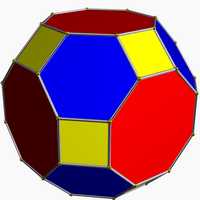Zero-symmetric graph


In the mathematical field of graph theory, a zero-symmetric graph is a connected graph in which all vertices are symmetric to each other, each vertex has exactly three incident edges, and these three edges are not symmetric to each other. More precisely, it is a connected vertex-transitive cubic graph whose edges are partitioned into three different orbits by the automorphism group.[1] In these graphs, for every two vertices u and v, there is exactly one graph automorphism that takes u into v.[2]
The name for this class of graphs was coined by R. M. Foster in a 1966 letter to H. S. M. Coxeter.[3]
Examples
The smallest zero-symmetric graph is a nonplanar graph with 18 vertices.[4] Its LCF notation is [5,−5]9.
Among planar graphs, the truncated cuboctahedral and truncated icosidodecahedral graphs are also zero-symmetric.[5]
These examples are all bipartite graphs. However, there exist larger examples of zero-symmetric graphs that are not bipartite.[6]
Properties
Every finite zero-symmetric graph is a Cayley graph, a property that does not always hold for cubic vertex-transitive graphs more generally and that helps in the solution of combinatorial enumeration tasks concerning zero-symmetric graphs. There are 97687 zero-symmetric graphs on up to 1280 vertices. These graphs form 89% of the cubic Cayley graphs and 88% of all connected vertex-transitive cubic graphs on the same number of vertices.[7]
| | Unsolved problem in mathematics: Does every finite zero-symmetric graph contain a Hamiltonian cycle? (more unsolved problems in mathematics) |
All known finite connected zero-symmetric graphs contain a Hamiltonian cycle, but it is unknown whether every finite connected zero-symmetric graph is necessarily Hamiltonian.[8] This is a special case of the Lovász conjecture that (with five known exceptions, none of which is zero-symmetric) every finite connected vertex-transitive graph and every finite Cayley graph is Hamiltonian.
See also
- Semi-symmetric graph, graphs that have symmetries between every two edges but not between every two vertices (reversing the roles of edges and vertices in the definition of zero-symmetric graphs)
References
- ↑ Coxeter, Harold Scott MacDonald; Frucht, Roberto; Powers, David L. (1981), Zero-symmetric graphs, Academic Press, Inc. [Harcourt Brace Jovanovich, Publishers], New York-London, ISBN 0-12-194580-4, MR 658666
- ↑ Coxeter, Frucht & Powers (1981), p. 4.
- ↑ Coxeter, Frucht & Powers (1981), p. ix.
- ↑ Coxeter, Frucht & Powers (1981), Figure 1.1, p. 5.
- ↑ Coxeter, Frucht & Powers (1981), pp. 75 and 80.
- ↑ Coxeter, Frucht & Powers (1981), p. 55.
- ↑ Potočnik, Primož; Spiga, Pablo; Verret, Gabriel (2013), "Cubic vertex-transitive graphs on up to 1280 vertices", Journal of Symbolic Computation, 50: 465–477, arXiv:1201.5317
 , doi:10.1016/j.jsc.2012.09.002, MR 2996891.
, doi:10.1016/j.jsc.2012.09.002, MR 2996891. - ↑ Coxeter, Frucht & Powers (1981), p. 10.